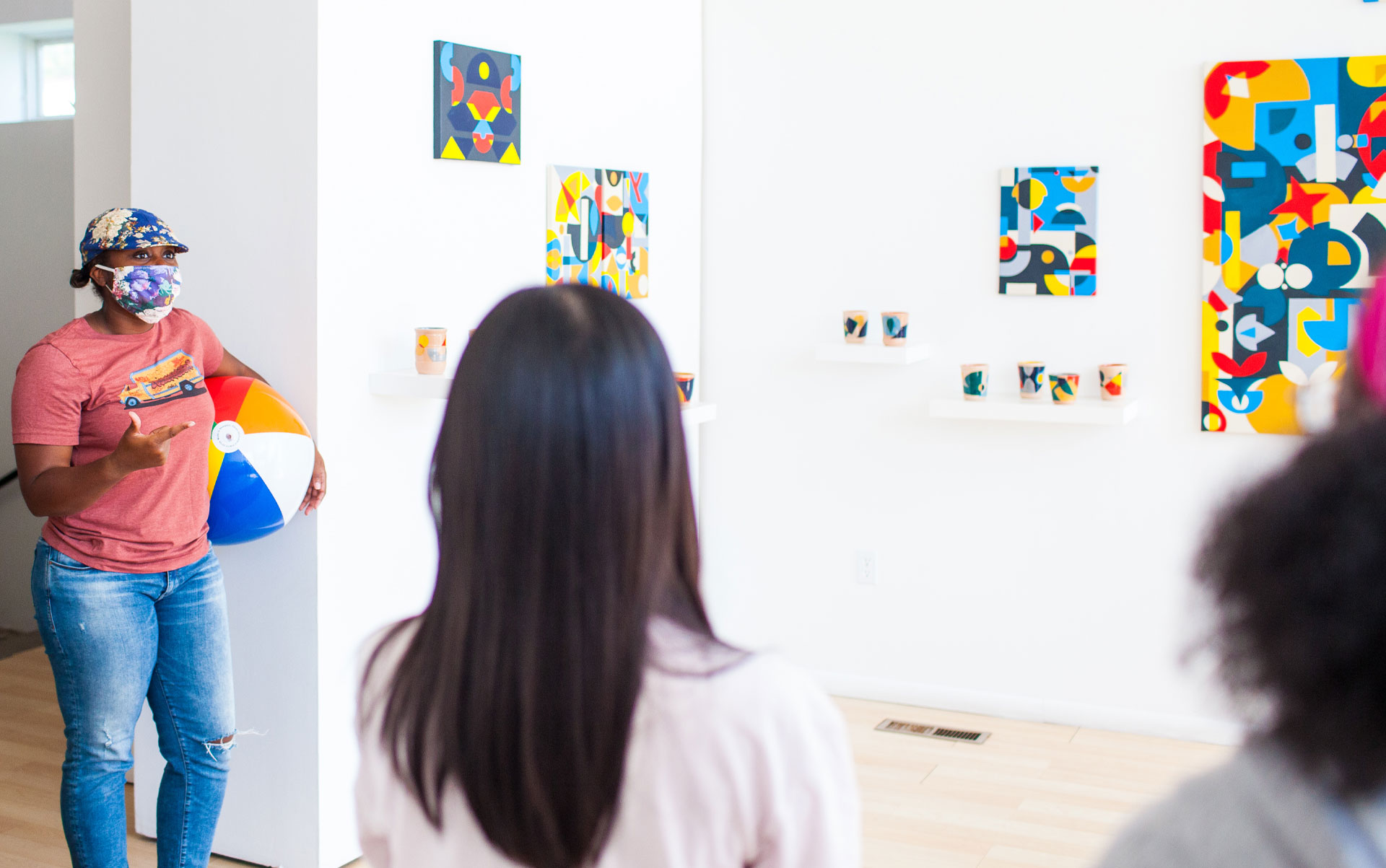
25 stories for 25 years. Since 1995, Juxtaposition Arts has provided arts education, employment, and development opportunities for young people in North Minneapolis. In 2020, 25 years since we started our work, we’re sharing 25 stories that help illustrate the impact, growth, and learning opportunities these 25 years have provided. We’re asking some of our alumni, artist collaborators, donors, clients, board and community members, and current program participants to share their stories. Follow along as we share the impact JXTA has had in just a quarter of a century.
Though Gabrielle officially joined the team at JXTA in 2019 as a Teaching Artist in the Contemporary Arts Lab, her relationship with the organization dates back over 15 years (read on to learn more). She holds a Master’s in Education in Youth Development and Leadership, and a Bachelor of Arts in Fine Arts and Youth Studies, both from the University of Minnesota-Twin Cities. She will also complete a post-graduate certificate program in Community and Family Engagement at Harvard University in the Summer of 2021.
Through her leadership in the Ceramics Lab, young artists mastered the experiential process of discovery, modality, and play; they developed many skills in the ancient art form which generated new techniques and expanded their capabilities. This development is demonstrative of what this new transition into leadership will look like in terms of strategy, change, and joy.
Her background in fine art, education, community engagement, administration, and youth development will serve her immensely as she transitions into this role. While a ceramics instructor at JXTA, she also held a full-time position as Director of Family and Community Engagement at Hiawatha Academies, and she was nominated by the GSEL as one of the region’s top 100 educators in 2020. We recently got to sit down with Gabrielle and talk all things JXTA, the Northside, and what she hopes for in this new position. Read the full interview below, and help us welcome Gabrielle to the JXTA Squad [please note: interview is edited for length and clarity].

JXTA:
Where were you born?
Gabrielle:
I was born in a small country town called Springfield Illinois.
JXTA:
Before working at JXTA, what kind of jobs did you have?
Gabrielle:
All of my jobs have been very similar to the work that I do at JXTA. They’ve always involved young people or children, and they’ve all been involved with community and education.
JXTA:
What year did you join JXTA and how long have you been working here?
Gabrielle:
That depends on how you think about the word “join.” I think that I was adopted into JXTA many years ago; the first time I participated as an artist with JXTA, I was 20 years old. Then I participated in all kinds of activities and events hosted by JXTA – mostly FLOW. I officially started working here after I finished school in 2019 [as the Ceramics instructor].
JXTA:
What were your initial impressions of the organization?
Gabrielle:
As a young person it was super cool that there was this space, basically in the middle of the hood, that provided all these opportunities for young people. I was blown away by that. As an adult and being employed here, it is incredibly rare to find organizations where people actually love each other and take care of each other and where there’s an immense amount of trust.
JXTA:
What challenges do you, or have you faced in your role(s) at JXTA?
Gabrielle:
This is so crazy because it’s not going to sound like a challenge, but it is. The fact that I even had to think about it is a blessing in and of itself. I think what’s been the most difficult at JXTA is the fact that we do so many things well. And because this seems so natural, it is really difficult at times to codify all the systems that make everything happen.
JXTA:
In your view, how has the work carried out at JXTA shifted, expanded, decreased, or ceased?
Gabrielle:
I think JXTA is the premier place in the state of Minnesota that merges youth development, community engagement, and social enterprise in very communal and humane ways. More specifically, I can’t think of any kind of person who wouldn’t feel like there’s a place for them here. It’s not necessarily an explicit part of the mission, values, or equity vision, but it’s demonstrated in the work. This has so much to do with being rooted in Black identity and Black culture; having a place to be able to express and hold that creates avenues of amazingness that allow other folks to come in and feel like they can embrace those parts of their culture or their identity that they have to hide in other spaces.
JXTA:
What are some of the most memorable experiences you’ve had at JXTA?
Gabrielle:
I think the very first memory I have is the immense JOY I felt from seeing bubbles on the roof. It seems so trivial, like it shouldn’t even be a memory, but it is locked in long-term. The fact that Roger has been embracing holding these bubbles down in the summer for so many years; it is something that I genuinely look forward to every Spring.
The second memory is of Roger pimping out low riders. On the back of these bikes there were card tables and checker games. The young people would just roll around in the neighborhood and ask passersby if they wanted to play games. The world that we live in tells us that we should fear people, our neighbors; stranger danger, and all of that. But riding around on a bike that’s full of games and encouraging folks to play the games on their porch? That’s memorable.
JXTA:
What parts of the organization stand out in your mind, either the building itself or the programs?
Gabrielle:
So, imagine the narrative about North Minneapolis being supposedly poverty-stricken and dirty and full of all the stereotypes that you can think about the Black community; and then you roll up to Emerson and Broadway and there’s bright, beautiful, attractive colors everywhere [from the murals decorating campus]. It stands in such contradiction to the way that people say the community is. Just in terms of the physical building itself; you can’t look at the beauty and the artistic expression and not feel something.
What also stands out to me is just the simple fact that JXTA has found a way to equitably pay young people beginning at the age of 13 in an internship program. That’s extremely rare. Most folks are not getting paid when they intern.

JXTA:
Why is JXTA important to the community?
Gabrielle:
I think it’s really hard for me to answer that question without thinking about it personally. JXTA provides an opportunity for people to believe that whatever is around you doesn’t have to be it. Rather, you don’t have to leave where you’re from to do something different or better. That your backyard is enough and maybe you haven’t taken the time to look around or spend time in the grass to contemplate how you might be able to alter, adapt, improve, or enhance what’s already there. And I think this is particularly critical for the Black community in North Minneapolis.
It’s critical to be able to go within and to be able to feel affirmed through an organization: that what you have going on and all the parts of you are enough. That they tell a story, a very significant story that can lead you towards adapting and growing skills that allow you to be more professional and/or that allow you to dig deeper into innate practices or gifts that you were born with and enhance them. You don’t have to be a poor struggling artist. You can develop and create skills that you can profit from and make money from.
JXTA:
What is the future you want to see for JXTA?
Gabrielle:
I’ve talked with Deanna and Roger about how much the world doesn’t give enough credit to how strategically visionary artists are. This is very connected to my own practice as an artist. People need to speak more fluently in that way. But the biggest thing that I want to see JXTA do is to codify the systems that are so…particular to JXTA.
I can’t think of a school, or any organization or people that work with young people nationally, or globally, that would not want to learn from JXTA. There’s an opportunity for JXTA to be a leader on a global scale around what it means to embrace where you’re from, to enhance the existing culture and drive it forward. That’s the opposite of what we’re told to do by society – to go get a job somewhere else, to leave the community. That means you’re exporting your contributions and abilities…but what does it mean to do that for the place where you’re from?
So that’s number one. Number two is codifying the curricula and what it means to be a non-traditional educator. If JXTA could really develop this, we could be in schools everywhere. The JXTA model, the JXTA way, JXTA arts in art classrooms, JXTA arts in afterschool programs…etc.
JXTA:
What do you hope to do to bring that future into being?
Gabrielle:
I am about maintaining the foundation that Roger and DeAnna created. The communal understanding on which this path was forged…I don’t take this lightly. I want to take my love for people, love for the community, and synergize that with my skillsets that drive every internal contributor of our organization to understand that we are a part of something so much bigger than us, so incredibly necessary, relevant, and needed. JXTA has not only healed parts of North Minneapolis but it will continue to be a beacon of actualization. Not what a young person or community member has to read about: they can physically see the evolution, right on the corner of Emerson and W. Broadway. I want to be a part of the legacy that contributes directly to the next wave of Black excellence, and I will be.
